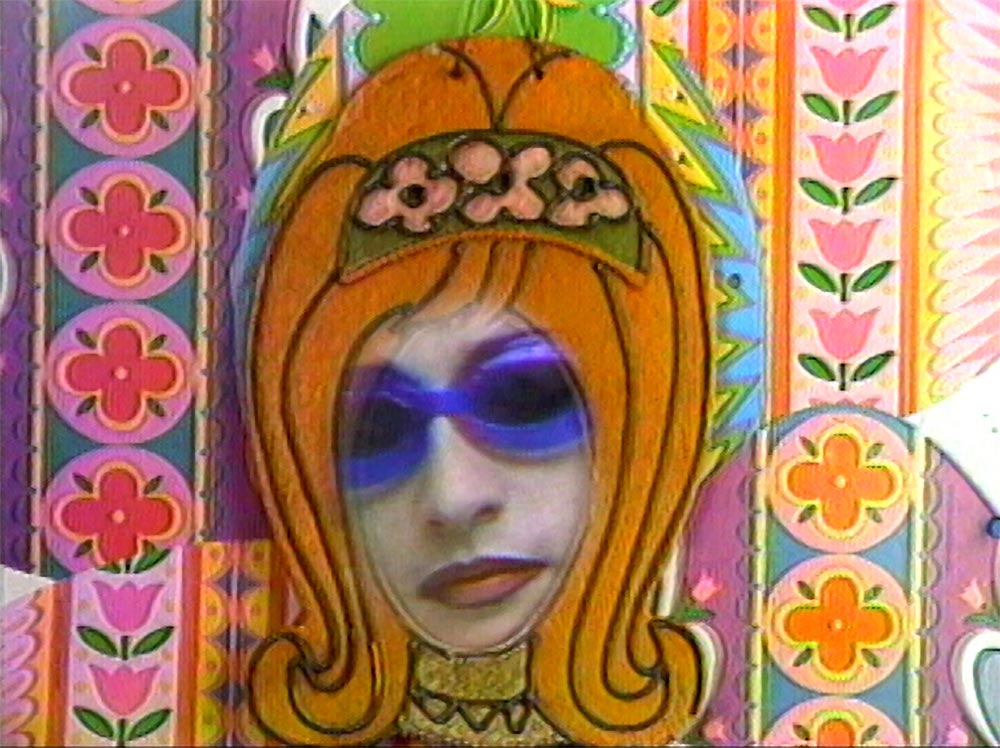“Community Drag Theater”—an outdoor screening organized by UnionDocs, Visual AIDS, and Video Data Bank—collects ten years of work by the hallucinogenic gay video maker and drag impresario Tom Rubnitz. While most queer video work from the age of AIDS and ACT UP brimmed with an urgent, revolutionary fervor and served as a delivery system for alternative, often life-saving, news, Rubnitz reveled in creating a freaky world of on-screen gay solace that was populated by an eclectic cast of friends, including Lady Bunny, RuPaul, musician John Sex, and the B-52s. Rubnitz and his collaborative performers were well-known to the eventide denizens of the East Village, where they would stage drag and variety shows at the Pyramid Club on Avenue A. This is immortalized in the program’s most straightforward document, From the Files of the Pyramid Cocktail Lounge (1983), a compilation of clips that’s shot in woozy broadcast video and was finished after Rubnitz’s death from AIDS-related illness in 1992.
It is impossible to watch Rubnitz’s video work—edited with Matt Danowski at New York’s Electronic Arts Intermix throughout the 1980s—and not think of its blend of drag culture and uncanny, overstimulating public access TV aesthetics as a massive influence on the look-and-feel of aughts internet art. Just as its feverish brethren, Cecilia Condit’s Possibly in Michigan (1983), was recently rediscovered and pounced upon by TikTokers, Rubnitz’s work experienced a period of YouTube virality about a decade ago. Viewers looking for a similar discovery will delight in 1991’s The Mother Show, co-directed by Barbara Lipp and Tom Koken, a pitch-shifted tribute to motherhood which feels like a sleep paralysis visitation.
Rubnitz playfully interrogated viewers' relationship to the television set, ramping up and exaggerating media and pop culture tropes to a frenzy. This is ably demonstrated in his collaboration with performer Ann Magnuson, Made for TV (1984). The title refers to Magnuson’s rapid-fire chameleonic changes in costume and persona; she portrays a dizzying amount of characters that she first hatched on the East Village stage interspersed with the changing channels of a TV set. Her TV evangelist persona Tammy Jan, known on stage for shilling Shroud of Turin beach towels, makes an appearance, as does an occultist named Moonbeam who sits opposite a horrified Republican woman on a debate show (Magnuson plays both women, as well as the host). We glimpse a black and white B-movie called Gidget Bites the Dust, with Magnuson as the main character, as well as a slightly vampiric newscaster foretelling the arrival of Soviet missiles (some of these segments made me recall Gregg Bordowitz’s comparison of being queer during the HIV epidemic to being imprisoned on a talk show in his 1993 film Fast Trip, Long Drop).
We see great stretches of Rubnitz’s alternative New York in Drag Queen Marathon (1986)—cheekily billed to the “Committee for Beauty and the International Businesswomen’s Association”—in which Rubnitz follows a traipsing group of queens, including Lady Bunny and the haiku-espousing Hapi Phace, on a jaunt from Lincoln Center, across Central Park, to the Guggenheim in search of willing photographers. Rubnitz layers on warping, colorful video effects, turning the streets of Manhattan into a hyperreal site of play.
The glittering gay world Rubnitz has crafted from New York is punctured in the program by 1992’s Listen to This, a collaboration with David Wojnarowicz produced in the year of both of the artists’ deaths. Crafted around a monologue that shares thematic relation with Wojnarowicz’s famed essay “Postcards from America: X-Rays from Hell”, the film is sobering and, as you would expect from Wojnarowicz and his intoxicating oratism, furious. Ripping back the layers of camp that clothe Rubnitz’s other works, Wojnarowicz performs as a personified television set, laying out plans for swallowing up and smothering the queer populace with misinformation. “I will make your life a schizophrenic hell if you refuse to buy into our one-tribe nation,” his character sneers through the screen. Eventually, as Wojnarowicz shifts to his personal remembrances, the screen goes black and his fury builds. Ironically, for the end of Rubnitz’s last film, this imagelessness elides another sort of drag—when Wojnarowicz would perform “X-Rays from Hell” in person, as he did at the legendary 1989 Artists Space exhibition Witnesses: Against Our Vanishing, he would often wear a rubbery mask of Ronald Reagan.
Tom Rubnitz: Community Drag Theater takes place tonight at UnionDocs.



